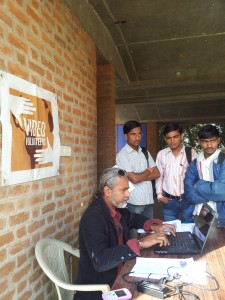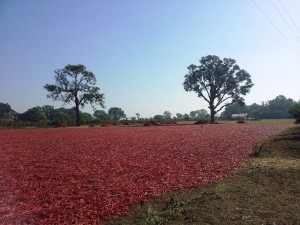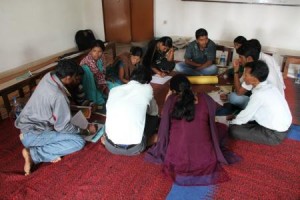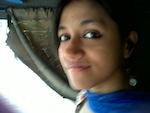 At Video Volunteers, we’re constantly asked two questions: how do you locate potential Community Correspondents? How do you find the right people in these remote corners of the country? So, we thought we’d explain the whole process from start to finish. We’ve written about the criteria for being a Community Correspondent HERE.
For most NGOs, accessing talented people in disconnected parts of the country is very challenging. VV is committed to not just training but to building a network. For that, we need to find people who will stay engaged for the long term. We’re proud of the length of engagement of many of our Community Correspondents, and that is a direct result of the time we put into selecting the right people.
We’re also committed to producing in-depth reports and in bringing out articulate ‘voices of communities.’ To do that, when working in areas with extremely high levels of marginalization, it means one has to really travel, talk and meet people. It means investing time and resources into recruitment and getting our hands dirty in the field, meeting the right activists, and understanding the issues of each state we work in.
Here’s an insider’s view on recruitment narrated by our motely recruitment team, who have meticulously put this formidable community of change makers together.
Prioritizing states:
Our goal is to have one Community Correspondent in every district, i.e. 645, within the next five years. We’re have around 130 total trained at the moment, and we are now growing state by state. Our first goal is to cover the conflict regions of Central India. As we make the annual plan for the year, we decide which states we want to expand to. Last year, it was Jharkhand, Chattisgarh, Orissa and Maharasthra. This year it is UP, MP, Bihar and an expanded presence in Jharkhand.
Research:
We then research the issues, key districts and activists in each state. We also research the media scene in that state. Research is not just the first step, but a continuing activity in VV’s recruitment.
Says Radhika, VV’s recruitment coordinator, “We have seven to eight criteria or indicators that we keep track of - starting at the state level, narrowing down to the district level– on atrocities on Dalit, forced evictions, state oppression, corruption, infant mortality, etc. We get the information from the mainstream and alternative media, our network of organizations and movement, contacts made through conferences and through our network of existing CCs.”
“The collated data identifies issues and concerns in regions across the country and prioritizes the need for the IndiaUnheard program in those regions. A comprehensive contact sheet of people in or associated with the regions and its movements and organizations is prepared. This is only the very beginning.”
Recruitment Trip Plan:
Radhika next plans a road trip through the region to meet all the key contacts.
Says Radhika, “By this time, we have a ballpark timeframe for the recruitment drive. We call through our contact sheet and try to source as many contacts of the people at the grassroots. We explain our agendas to them and ask them for their support and goodwill. We schedule appointments and meetings with them.”
“All these go on a Google map and we have our route traced on paper before we set off from the office.”
The Recruitment Drive:
At Video Volunteers, we’re constantly asked two questions: how do you locate potential Community Correspondents? How do you find the right people in these remote corners of the country? So, we thought we’d explain the whole process from start to finish. We’ve written about the criteria for being a Community Correspondent HERE.
For most NGOs, accessing talented people in disconnected parts of the country is very challenging. VV is committed to not just training but to building a network. For that, we need to find people who will stay engaged for the long term. We’re proud of the length of engagement of many of our Community Correspondents, and that is a direct result of the time we put into selecting the right people.
We’re also committed to producing in-depth reports and in bringing out articulate ‘voices of communities.’ To do that, when working in areas with extremely high levels of marginalization, it means one has to really travel, talk and meet people. It means investing time and resources into recruitment and getting our hands dirty in the field, meeting the right activists, and understanding the issues of each state we work in.
Here’s an insider’s view on recruitment narrated by our motely recruitment team, who have meticulously put this formidable community of change makers together.
Prioritizing states:
Our goal is to have one Community Correspondent in every district, i.e. 645, within the next five years. We’re have around 130 total trained at the moment, and we are now growing state by state. Our first goal is to cover the conflict regions of Central India. As we make the annual plan for the year, we decide which states we want to expand to. Last year, it was Jharkhand, Chattisgarh, Orissa and Maharasthra. This year it is UP, MP, Bihar and an expanded presence in Jharkhand.
Research:
We then research the issues, key districts and activists in each state. We also research the media scene in that state. Research is not just the first step, but a continuing activity in VV’s recruitment.
Says Radhika, VV’s recruitment coordinator, “We have seven to eight criteria or indicators that we keep track of - starting at the state level, narrowing down to the district level– on atrocities on Dalit, forced evictions, state oppression, corruption, infant mortality, etc. We get the information from the mainstream and alternative media, our network of organizations and movement, contacts made through conferences and through our network of existing CCs.”
“The collated data identifies issues and concerns in regions across the country and prioritizes the need for the IndiaUnheard program in those regions. A comprehensive contact sheet of people in or associated with the regions and its movements and organizations is prepared. This is only the very beginning.”
Recruitment Trip Plan:
Radhika next plans a road trip through the region to meet all the key contacts.
Says Radhika, “By this time, we have a ballpark timeframe for the recruitment drive. We call through our contact sheet and try to source as many contacts of the people at the grassroots. We explain our agendas to them and ask them for their support and goodwill. We schedule appointments and meetings with them.”
“All these go on a Google map and we have our route traced on paper before we set off from the office.”
The Recruitment Drive:
 The recruitment drive is an actual drive – over potholed roads, along distant unfamiliar landscapes, into the heart of the region. Stalin and Radhika (who have done most of the recruitment drives over the last two years) do an average trip of 14 days, to meet approximately 90 people and drive about 4000 kilometers. These might be twenty- minute meetings by the side of the road with two activists, or an hour long presentation at an NGO’s community gathering. The purpose is to tell people about the IndiaUnheard program, hand out application forms, ask their opinions on key issues to cover, people to meet, and to inspire them to spread the word. We urge them to emphasize that this is a paid position – each CC gets at least Rs.1500 per video. At the meetings, we tell them the dates we’ve fixed for the selection workshop, and ask them how many people they think they can send. The local contacts are often activists doing great work but with no recognition and often few contacts outside the state. It becomes clear that they can benefit from the IndiaUnheard program giving a wider platform to their struggles.
Radhika describes the recruitment drive as an anxious fever that attains a critical momentum. She says, “The research is tested. Our perspectives change. Issues and concerns which once seemed distant now appear acute and immediate. The need for the IndiaUnheard program is understood and it takes hold on your heart and mind. Every time I have gone on a recruitment drive, we have ended up identifying more issues and more priority regions than we started off with.”
Radhika recalls her visit to Dhinkia, the heart of the anti-POSCO movement, “We lost track of our directions and when we stopped and asked people to help guide us they asked us to move away. ‘It’s a Naxal region.’ they told us, ‘don’t go there. Go back from where you came. It’s dangerous for you.’ But we went nonetheless. And it was a completely different picture inside. And I realized that the region was so cutaway that not even the neighboring villages had any clue of what was going on inside. Now this is region that desperately needed a voice on the IndiaUnheard platform.”
“The drive is exhausting, challenging, even exasperating but ultimately inspiring. At each of these meetings, we give a presentation on IndiaUnheard. We meet strangers with powerful voices and powerful stories that have so far gone unheard. It helps us identify the people we want to work and associate with in the region. More importantly, it gives a shape and perspective to our mission.”
(Read Radhika’s account of the Chhattisgarh recruitment drive here)
Shortlisting Candidates:
The recruitment drive is an actual drive – over potholed roads, along distant unfamiliar landscapes, into the heart of the region. Stalin and Radhika (who have done most of the recruitment drives over the last two years) do an average trip of 14 days, to meet approximately 90 people and drive about 4000 kilometers. These might be twenty- minute meetings by the side of the road with two activists, or an hour long presentation at an NGO’s community gathering. The purpose is to tell people about the IndiaUnheard program, hand out application forms, ask their opinions on key issues to cover, people to meet, and to inspire them to spread the word. We urge them to emphasize that this is a paid position – each CC gets at least Rs.1500 per video. At the meetings, we tell them the dates we’ve fixed for the selection workshop, and ask them how many people they think they can send. The local contacts are often activists doing great work but with no recognition and often few contacts outside the state. It becomes clear that they can benefit from the IndiaUnheard program giving a wider platform to their struggles.
Radhika describes the recruitment drive as an anxious fever that attains a critical momentum. She says, “The research is tested. Our perspectives change. Issues and concerns which once seemed distant now appear acute and immediate. The need for the IndiaUnheard program is understood and it takes hold on your heart and mind. Every time I have gone on a recruitment drive, we have ended up identifying more issues and more priority regions than we started off with.”
Radhika recalls her visit to Dhinkia, the heart of the anti-POSCO movement, “We lost track of our directions and when we stopped and asked people to help guide us they asked us to move away. ‘It’s a Naxal region.’ they told us, ‘don’t go there. Go back from where you came. It’s dangerous for you.’ But we went nonetheless. And it was a completely different picture inside. And I realized that the region was so cutaway that not even the neighboring villages had any clue of what was going on inside. Now this is region that desperately needed a voice on the IndiaUnheard platform.”
“The drive is exhausting, challenging, even exasperating but ultimately inspiring. At each of these meetings, we give a presentation on IndiaUnheard. We meet strangers with powerful voices and powerful stories that have so far gone unheard. It helps us identify the people we want to work and associate with in the region. More importantly, it gives a shape and perspective to our mission.”
(Read Radhika’s account of the Chhattisgarh recruitment drive here)
Shortlisting Candidates:
 There is a two to three week window after the recruitment drive when applications begin arriving in the Goa office by post and courier. The application forms contain basic data relating to contact details and financial situation.
The data from the application forms are collated and each applicant receives a phone call from the Goa office. She/he is interviewed to ratify the content of the forms. They are then given the date for the two day selection camp to be organized in their state.
The referees and resource persons who recommended the candidates are also called and informed about the selection camp. The recruitment team then travels back to the state for the selection camp.
The Selection Camp:
“A selection camp has the possibility to go crazy,” says Amrita, a coordinator at VV who also works on recruitment. “Sometime you are expecting a 100 people and only 30 turn up. There have been times when you expect 40 and 80 turn up. It’s maddening. The logistics can bring the roof down.”
All suitable candidates gather at the selection site and the VV recruitment team is joined by the training team to put the prospective correspondents through the paces.
Says Amrita, “Other than our stated criteria we are looking for leadership qualities, experience in activism, a willingness to take initiative and a deep understanding of the issues they are facing.” Empathy and a visceral sensitivity to the issues of their communities and a commitment to righting them are essential in a prospective CC
Group Discussion:
There is a two to three week window after the recruitment drive when applications begin arriving in the Goa office by post and courier. The application forms contain basic data relating to contact details and financial situation.
The data from the application forms are collated and each applicant receives a phone call from the Goa office. She/he is interviewed to ratify the content of the forms. They are then given the date for the two day selection camp to be organized in their state.
The referees and resource persons who recommended the candidates are also called and informed about the selection camp. The recruitment team then travels back to the state for the selection camp.
The Selection Camp:
“A selection camp has the possibility to go crazy,” says Amrita, a coordinator at VV who also works on recruitment. “Sometime you are expecting a 100 people and only 30 turn up. There have been times when you expect 40 and 80 turn up. It’s maddening. The logistics can bring the roof down.”
All suitable candidates gather at the selection site and the VV recruitment team is joined by the training team to put the prospective correspondents through the paces.
Says Amrita, “Other than our stated criteria we are looking for leadership qualities, experience in activism, a willingness to take initiative and a deep understanding of the issues they are facing.” Empathy and a visceral sensitivity to the issues of their communities and a commitment to righting them are essential in a prospective CC
Group Discussion:
 The ice is broken with a few quick and fun exercises before the session moves into group discussion.
“Even the basic introductions gives you clues into a person’s views and experiences”, says Amrita.
The moderators introduce social issues and ask the group to articulate them in the context of their community. As the candidates speak, the moderators play the devil’s advocate trying to provoke them into revealing their emotions and passion.
We push people to speak on subjects like gender, sexuality, discrimination, etc. We want prejudices to come forth and to see how they react to being faced with different opinions. “Tensions run high and sometimes the intensity is unbelievable”, says Amrita.
The moderators keep watch at an arm’s length. They want the candidates to resolve the issues among themselves. Grace shown under pressure and during times of stress is highly rated by the VV teams.
The Interviews:
After the fever of group discussions, the candidates are grilled one-on-one by VV staff. The candidates are mostly asked about their prior experience. Questions that remain unresolved at the group discussion are introduced. During the interview, the team clarifies and makes final notes on the candidates.
The Final Meeting:
The VV team gathers away from the crowd for the final meeting.
“By now it is pure instinct,” says Radhika. “Every team member has their favorite candidates and they are prepared to fight for them.”
Amrita insists it is a ‘long discussion’ but Radhika sticks to ‘fight’.
The world stands still as the team settles the final shortlist among themselves. By this time we have no recorded facts of what goes on. But there are florid rumors going around.
The door remains closed. One can never say for how long. Inside each member of the VV team stakes honor and life as it tries to retain their candidate as a Community Correspondent. Threats and loud noises were reported. Injuries and scratches were seen. Throats were sore. Some furniture and a few windows had to be compensated for.
When the door opens and a strange light pours through. Through the light, appears a very tired, very exhausted VV team. In the hands of the team is a piece of paper. On the paper is the final shortlist of those who made it as ‘Community Correspondents’.
The one’s who didn’t make the list say their goodbyes and leave for home. The ones who stay will now learn how to change the country, one video at a time.
And the recruitment team returns to their excel sheets. The next training is just around the corner.
Introducing the Recruitment Team:-
The ice is broken with a few quick and fun exercises before the session moves into group discussion.
“Even the basic introductions gives you clues into a person’s views and experiences”, says Amrita.
The moderators introduce social issues and ask the group to articulate them in the context of their community. As the candidates speak, the moderators play the devil’s advocate trying to provoke them into revealing their emotions and passion.
We push people to speak on subjects like gender, sexuality, discrimination, etc. We want prejudices to come forth and to see how they react to being faced with different opinions. “Tensions run high and sometimes the intensity is unbelievable”, says Amrita.
The moderators keep watch at an arm’s length. They want the candidates to resolve the issues among themselves. Grace shown under pressure and during times of stress is highly rated by the VV teams.
The Interviews:
After the fever of group discussions, the candidates are grilled one-on-one by VV staff. The candidates are mostly asked about their prior experience. Questions that remain unresolved at the group discussion are introduced. During the interview, the team clarifies and makes final notes on the candidates.
The Final Meeting:
The VV team gathers away from the crowd for the final meeting.
“By now it is pure instinct,” says Radhika. “Every team member has their favorite candidates and they are prepared to fight for them.”
Amrita insists it is a ‘long discussion’ but Radhika sticks to ‘fight’.
The world stands still as the team settles the final shortlist among themselves. By this time we have no recorded facts of what goes on. But there are florid rumors going around.
The door remains closed. One can never say for how long. Inside each member of the VV team stakes honor and life as it tries to retain their candidate as a Community Correspondent. Threats and loud noises were reported. Injuries and scratches were seen. Throats were sore. Some furniture and a few windows had to be compensated for.
When the door opens and a strange light pours through. Through the light, appears a very tired, very exhausted VV team. In the hands of the team is a piece of paper. On the paper is the final shortlist of those who made it as ‘Community Correspondents’.
The one’s who didn’t make the list say their goodbyes and leave for home. The ones who stay will now learn how to change the country, one video at a time.
And the recruitment team returns to their excel sheets. The next training is just around the corner.
Introducing the Recruitment Team:-

1. Radhika Gupta - One and a half years with Video Volunteers, Radhika is now at the centre of VV’s recruitment processes. In her time with the organization she has reviewed and interviewed prospects for over 1000s of possible Community Correspondents. She has traveled extensively across the eastern states of Chhattisgarh and Odisha visiting some of the most troubled districts for the perfect candidate. 80 of the finest have made the cut till date.
 2. Amrita Anand – Six months in the organization, Amrita has been assisting Radhika in recruitment. Amrita recently went on a two week long road trip across the third largest state, Maharashtra, in a rickety old jeep in search of Community Correspondents in some of the most interior regions. She has helped bring in over 45 Community Correspondents into the VV fold.
The Video Volunteers Recruitment Timeline (March 2010 – June 2013):-
2. Amrita Anand – Six months in the organization, Amrita has been assisting Radhika in recruitment. Amrita recently went on a two week long road trip across the third largest state, Maharashtra, in a rickety old jeep in search of Community Correspondents in some of the most interior regions. She has helped bring in over 45 Community Correspondents into the VV fold.
The Video Volunteers Recruitment Timeline (March 2010 – June 2013):-
- March 2010 - 30 Community Correspondents from across the country (the first batch)
- March 2011 - 27 Community Correspondents from across the country
- January 2012 – 26 Community Correspondents from Jharkhand
- August 2012 – 16 Community Correspondents from Chhattisgarh
- September 2012 – 16 Community Correspondents from Odisha
- January 2012 – 17 Community Correspondents from Maharashtra
- February 2013 – 10 Community Correspondents across UP, Bihar, MP
- May 2013 – 30 Community Correspondents from Jharkhand (planned)
- June 2013 - 42 Community Correspondents across UP, Bihar, MP (planned)
Fighting for Change: The Story of Bihar-Based Journalist Amir Abbas
Inspiration can come from many sources, but one of the most powerful is seeing someone walk the path before you. Our Community Correspondent, Syed Amir Abbas found his inspiration in Stalin K., the founding director of Video Volunteers. “I met Stalin at VV’s national meet in 2017 and I...
The happiness that comes with an yearly bonus
This video is a story of success, a story of a small win against a giant corporation. A story of persistence and a never-say-die attitude. This year, the workers of 3 gardens in the Alipurduar area of Kumargram Block, received a slightly increased yearly bonus, an increase of 3%, from...
